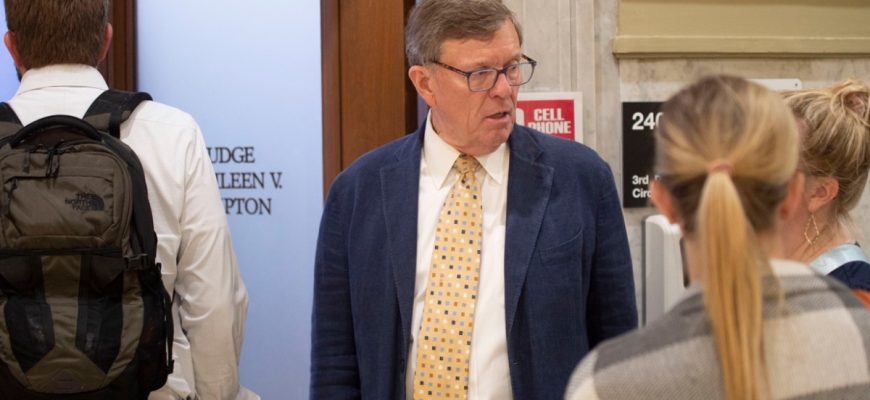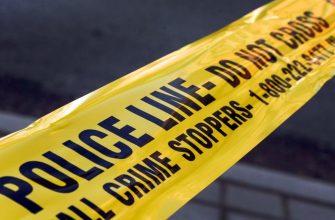
It was a long day for the folks in Pulaski County Judge Cathi Compton’s court on Thursday as the Dennis Rainey trial continued. The 12-member jury heard from three witnesses who showed photos of Rainey’s land overlooking Lake Maumelle in Roland, dug into the tedious details of various appraisal procedures and talked internal communications at Central Arkansas Water.
Rainey, 75, is facing a felony criminal mischief charge for damaging more than 100 trees in 2021 to improve his backyard view. His team, led by Attorney David Parker, is arguing that Rainey had permission to cut his trees from Little Rock Municipal Water Works — now Central Arkansas Water — in the 1990s. The state team, led by Prosecuting Attorney Robert Jones, is actively pushing against that narrative, saying Rainey did not have permission to do so, and the trimming racked up over $109,000 worth of damages. The three-day trial started Wednesday with testimony from four witnesses. Catch up on day one here.
Bryan Rupar took the witness stand first on Thursday. Rupar is a land conservation coordinator with Central Arkansas Water, and he has worked there for the last three years. He became involved in the Rainey tree trimming case early on, and took a drone out over the property in August 2021, a few months after the trees were cut. The drone footage, both video and photo, clearly showed a bald spot near Rainey’s home.
Rupar noted that trees were damaged beyond Rainey’s property line and into the land that Central Arkansas Water owns as part of the watershed for Lake Maumelle, a drinking water source. Rupar also said that at least three trees with boundary markers had been removed. The damage ranged from full removal to limbing and topping, which are methods commonly used around power lines, but were used for view enhancement in Rainey’s case.
The damage done to the trees on and near Rainey’s property was “extremely debilitating” to the trees, Rupar said. When trees are cut from the top in the spring, the trees lose a lot of their energy sources to make new leaves. The treatment will also put trees at risk from insects and rot. Rupar revisited Rainey’s property in December 2021 to collect additional drone footage to see how the area was affected.
The December footage objectively showed a major difference between the trees behind Rainey’s house and the rest of the surrounding forest. A photo looking up from the lake toward Rainey’s house showed a distinct cut-out of where the trees were trimmed. Rupar said he visited the land again in September 2022, and it did not look the same at all; there was a complete loss of canopy height.
The $109,000 tree evaluation was also Rupar’s doing. He used a method called the trunk formula technique, which was recommended by an expert at the U.S. Army Corps of Engineers, Little Rock district. Rupar said he reached out to five institutions who deal with similar tree work and decided to use the recommendation of the Corps because it was the only one that also handled watershed-adjacent property.
With two interns marking trees to ensure nothing was counted twice, Rupar took the measurements and calculations for 111 damaged trees. The data varied; some trees had lost 90% of their canopy, while others just lost 10%. Rainey’s attorney Parker disputed the use of the trunk formula technique. He questioned if the appraisal was real estate, and if the trees on a property could be worth more than the acre itself.
Parker also noted that in an email of Rupar’s final evaluation findings, he described two scenarios. One was the actual real data collected, and the other was a hypothetical scenario if the exact same trees were being measured in a different location that was not public use space, was not a watershed and did not have a national trail running through it. The hypothetical produced a damage amount of about $31,000. Rupar said the team at Central Arkansas Water determined that the first scenario was appropriate.
Rupar spent a good chunk of time arguing the value of the trees. He explained that they were the first line of defense against erosion in the area and helped to stabilize the soil. He also said that based on his evaluation, it was safe to assume that the acre of land was worth more than $109,000. In his time working at CAW, Rupar said that he did not know of a purchase of an acre for more than $10,000, but that land was also not lakefront, on a reservoir and including a national trail.
Raven Lawson, the watershed protection manager at Central Arkansas Water, was next up on the witness stand. She said that of 88,000 acres of watershed property, just 8,900 of it was Lake Maumelle. Clearing land is not permitted in the area, and if someone would have asked permission to trim trees in the area, Lawson would not have OK’d it, she said. Lawson has worked at CAW for about nine years.
Lawson was involved with the Rainey case almost immediately as citizen Rhonda Patton — who testified Wednesday — was in quick contact with her in May 2021. Less than two weeks after becoming aware of the tree trimming, Lawson had a meeting with her supervisor, Rainey and his wife, Barbara. The group discussed the situation at hand, and during the conversation, Rainey mentioned that he had “friends in high places” that could attest to his character or help out Central Arkansas Water. Former Gov. Mike Huckabee was mentioned, as were thousands of online followers that could reach out to Lawson. In general, Lawson said that the meeting was “cordial and informative.”
Rainey’s attorney Parker questioned Lawson’s motives. He presented emails in which Lawson described having a perception that Rainey was a wealthy man and that the penalty for cutting the trees should be significant enough to veer others away from doing the same thing. She also brainstormed a possible mesh netting to interfere with Rainey’s view, potentially with solar lights to be “more annoying.”
Parker also showed Lawson a different family’s deed from the Little Rock Municipal Water Works in the 1990s that allowed tree trimming. Lawson said she was unaware of the deed, or any others that may exist like it. Prosecuting Attorney Jones later noted that the same deed included language that any trimming would still require current written permission.
Digging into Rupar’s damaged tree evaluation, Lawson said that she was unaware of any review. A separate appraisal from Michael Marter, an employee with DDK Forestry & Real Estate, set the damages at $1,048. Lawson said that value merely included the cost of timber and did not take into account the value of the damage to living trees on the property.
The final witness to take the stand on Thursday was the first from the defense’s side. David Reinold, a registered forester and appraiser who lives in Russellville, testified that the trunk formula technique was not appropriate in Rainey’s case. Reinold took his first trip out to the Rainey property in April 2023 and conducted his own appraisal of the damage. He totaled it at $65.90 for seven dead trees.
Reinold noted he surveyed 77 trees that were somewhat damaged from trimming or topping, as well as 19 smaller trees that he said had no impact on the land. Reinold’s calculation does not include any damage to trees that are healing, i.e. any tree that was trimmed but is still growing.
The state argued that because Reinold visited the property so long after Rainey had the trees cut in May 2021, he had missing data for how tall the trees were originally. Jones also argued that putting value on something was subjective, which Reinold disagreed with. The $109,000 damage charge was outlandish to Reinold, and he said if the property was worth that much, he would need an explanation as to why. He also disagreed that the property was lakefront.
Court is in recess until 8:45 a.m. Friday. The goal is to wrap things up Friday as Compton has a full schedule next week and isn’t positive when the trial could continue.








